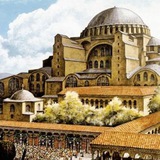Now I propose to take a look at a baroque beauty from Serbia - the church in Sombor dedicated to today's holiday.
❤19🔥1
Finally, at the end of today's selection is one of the most beautiful churches of ancient Uglich, dedicated to the Nativity of John the Baptist and built in the heyday of the city's church building - in the XVII century.
Its history is sadly intertwined with the history of the most famous saint of the town - Prince Demetrius, because it was built in memory of another murdered boy - the son of local merchant Nikifor Chepolosov, who was killed at the age of six by a Nikifor's clerk.
Its history is sadly intertwined with the history of the most famous saint of the town - Prince Demetrius, because it was built in memory of another murdered boy - the son of local merchant Nikifor Chepolosov, who was killed at the age of six by a Nikifor's clerk.
❤🔥12❤7😢4
Modern Moldavia has always been a place where Moldavian (and Romanian in general) and Russian cultures met, which, of course, could not but be reflected in the local architecture.
Interesting in this regard is the church of St. George in Ocniţa - its construction in neo-Russian style began before the revolution, but for obvious reasons was not finished. The church was completed in the Neo-Moldavian style by Romanian craftsmen, which created a very interesting look - emphasized also during the restoration of the church in our time after the Soviet years, with frescoes in a style closer to Romania and a Neo-Russian iconostasis.
Interesting in this regard is the church of St. George in Ocniţa - its construction in neo-Russian style began before the revolution, but for obvious reasons was not finished. The church was completed in the Neo-Moldavian style by Romanian craftsmen, which created a very interesting look - emphasized also during the restoration of the church in our time after the Soviet years, with frescoes in a style closer to Romania and a Neo-Russian iconostasis.
❤🔥12❤9
A piece of old Moscow, hidden between modern offices and Soviet blocks - the only surviving chambers of the original Khamovnaya Sloboda, which originally emerged as a weaving district, but by the mid XVII turned into an industrial one - thanks to the creation of Khamovny Court - a large linen manufactory.
❤11😍3🔥2👍1
Today the Orthodox Church remembers the Apostles Peter and Paul, in honour of which I propose to take a look at the Peter and Paul Church, once a cathedral, in Minsk. Built in the XVII century, when there were no Orthodox churches left in Minsk, by the will of providence it became the oldest church that survived to our days in the city in principle. Having been built already in the times of the Uniate domination, it is a rare example even for Belorussia of an originally Orthodox basilica Russian temple, and at the same time it is the only Renaissance building in Minsk.
🔥10❤6
